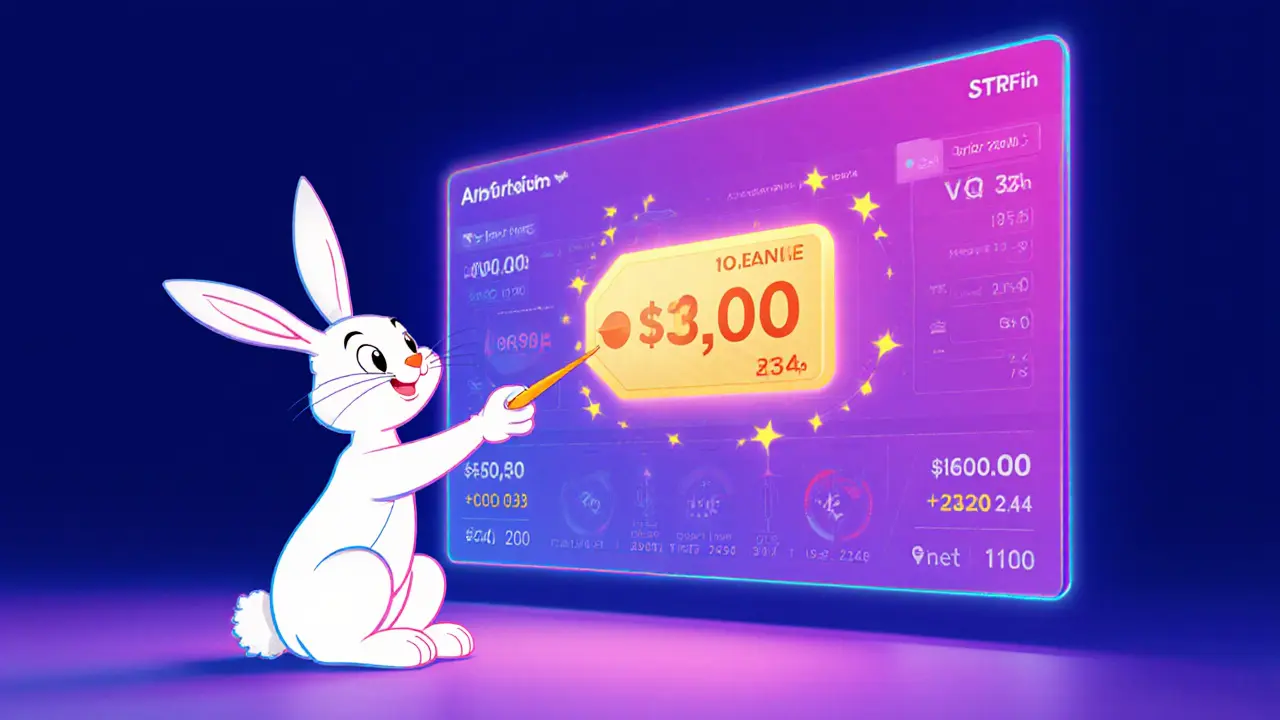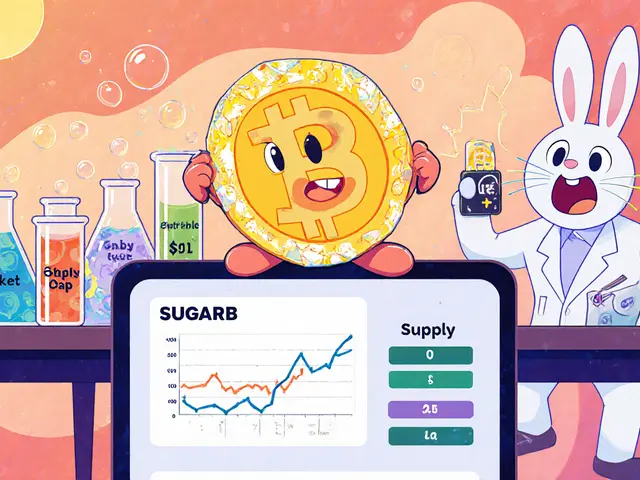
STR Token Price Tracker
STR Token Price
About Sterling Finance
Sterling Finance is a Solidly-fork DEX on Arbitrum with extremely low liquidity. This tool helps track its STR token performance.
Token Metrics
Market Cap
$0.00
Volume (24h)
$0.00
Liquidity
$0.00
Performance Simulation
Quick Take
- Sterling Finance is a Solidly‑fork DEX on Arbitrum with extremely low liquidity (<$25 daily volume).
- Its native STR token shows a total supply of 0 but claims 100,000 circulating, causing token‑omics red flags.
- Price sits around $0.01, down almost 90% from recent highs.
- Trading experience is hampered by massive slippage and near‑zero order‑book depth.
- Confusion with a similarly named broker, Sterling FinanceAG, adds reputational risk.
What Is Sterling Finance?
When people talk about Sterling Finance a decentralized exchange (DEX) and DeFi protocol built on the Arbitrum network, they are referring to a platform that markets itself as a "Solidly fork." Solidly, originally created by AndreCronje, introduced a novel AMM model that rewards liquidity providers with more efficient price curves. Sterling Finance attempts to copy that model while positioning itself on Arbitrum to benefit from lower gas fees compared with Ethereum mainnet.
In practice, the protocol offers a basic spot‑trading UI, an automated market maker (AMM) pool for the native STR token, and a handful of liquidity mining incentives. There is no centralized order book, no custodial holdings, and no explicit governance portal that is publicly documented.
Tokenomics of the STR Token
The STR token the native utility token of the Sterling Finance protocol raises immediate eyebrows. The contract (0x5DB7…C51D68 on Arbitrum) reports a total supply of **0**, yet the self‑claimed circulating supply is 100,000STR. This mismatch suggests that the token contract is either incomplete or intentionally obfuscated.
- Supply claims: 0 total vs 100,000 circulating.
- Current price: roughly $0.0095-$0.01 per token (as of Oct2025).
- Market cap: under $1,000, given the minuscule price and supply.
- Utility: fee discounts on the DEX, governance voting (if any), and liquidity mining rewards.
Without clear documentation on minting, burning, or distribution mechanisms, investors lack confidence in the token’s long‑term value proposition.
Market Performance and Liquidity
Liquidity is the lifeblood of any DEX, and Sterling Finance appears to be in cardiac arrest. Recent data shows:
- 24‑hour trading volume: $23,900 total, with spot volume under $22 and DEX volume just $14.66.
- Average daily volume over the past week: less than $25.
- Bid‑ask spreads often exceed 50% due to the shallow pool.
Such thin trading activity means that even tiny orders can cause massive price impact, making the platform unsuitable for anyone looking to execute meaningful trades.

How the AMM Model Works on Sterling Finance
Being a Solidly fork, the protocol uses a constant‑product formula (x·y=k) with a twist: it introduces a “stable‑swap” curve for low‑volatility pairs and a “volatile‑swap” curve for more speculative assets. The fee structure is typically 0.25% on swaps, slightly lower than Uniswap’s 0.30% but irrelevant when there is almost no liquidity.
Users who deposit STR into the pool receive LP tokens that represent their share of the pool. However, because the pool size is practically zero, LP rewards are negligible, and the risk of impermanent loss is high relative to any potential gain.
Safety Concerns and the Sterling FinanceAG Confusion
A separate entity called Sterling FinanceAG a broker that has been flagged as unsafe by consumer watchdogs operates in the traditional finance space. BrokerChooser warns that Sterling FinanceAG is “not a safe and trusted choice.” The name similarity creates a branding clash that can mislead novices searching for the DeFi protocol.
Beyond the naming issue, the DEX lacks clear governance, a publicly audited smart‑contract audit, and any regulatory disclosures. Combined with the token‑supply oddities, the platform carries a high risk profile.
How Sterling Finance Stacks Up Against the Big Kids
| Platform | 24h Volume (USD) | Liquidity (USD) | Swap Fee |
|---|---|---|---|
| Sterling Finance | $25 | ≈ $100 | 0.25% |
| Uniswap (Arbitrum) | $1.2B | $15B | 0.30% |
| SushiSwap (Arbitrum) | $240M | $3B | 0.25% |
Even when compared to other Arbitrum‑based DEXes, Sterling Finance offers negligible liquidity and volume. The fee advantage is moot because traders cannot reliably execute swaps without huge slippage.
User Experience and Community Pulse
Scanning social channels (Twitter, Reddit, Discord) turns up virtually no activity tied to Sterling Finance. There are no official community groups, no AMA sessions, and no developer blog updates. The lack of a vibrant community often correlates with low liquidity, as providers tend to follow where traders congregate.
From the few anecdotal reports, users who tried to trade on the platform encountered:
- Transaction failures due to out‑of‑gas errors despite Arbitrum’s low fees.
- Extreme price impact on orders as low as 0.01STR.
- No clear customer support or escalation path.
All signs point to a project that either stalled shortly after launch or never gained traction beyond a handful of developers.
Should You Use Sterling Finance?
If you are a curiosity‑driven explorer who enjoys testing new AMM designs, you might allocate a tiny amount of capital (under $10) to see how the UI feels. However, for anyone looking to trade, provide liquidity, or hold STR as an investment, the risks outweigh any potential upside:
- Illiquid market → massive slippage.
- Obscure tokenomics → unclear supply and valuation.
- No audit or governance → security blind spot.
- Name confusion with a flagged broker → reputational danger.
Until the team publishes a transparent roadmap, an audited contract, and demonstrates real liquidity growth, the prudent move is to steer clear.

Frequently Asked Questions
Is Sterling Finance a safe platform to trade on?
Safety is questionable. The protocol lacks a public audit, has almost no liquidity, and its token supply data is inconsistent. Additionally, the similar name to a flagged broker adds confusion, so most users should avoid it until more transparency is provided.
What is the current price and market cap of the STR token?
STR trades around $0.0095-$0.01, giving it a market cap of less than $1,000 based on the claimed 100,000 circulating supply.
How does Sterling Finance differ from Uniswap?
Both are AMM DEXes, but Uniswap handles billions in daily volume and has deep liquidity pools, while Sterling Finance barely trades $25 a day with negligible liquidity, making swaps impractical.
Can I earn rewards by providing liquidity to STR?
The protocol offers LP tokens, but because the pool size is effectively zero, rewards are trivial and the risk of impermanent loss outweighs any potential gain.
Is Sterling Finance related to Sterling FinanceAG?
No. Sterling FinanceAG is a traditional broker that has been flagged as unsafe. The similarity in names is coincidental but creates confusion, so verify you are looking at the DeFi protocol on Arbitrum, not the broker.





